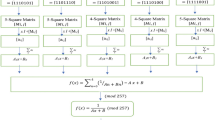Abstract
Recent study shows that substitution box (S-box) only cannot be reliably used in image encryption techniques. We, in this paper, propose a novel and secure image encryption scheme that utilizes the combined effect of an algebraic substitution box along with the scrambling effect of the Arnold transform. The underlying algorithm involves the application of S-box, which is the most imperative source to create confusion and diffusion in the data. The speciality of the proposed algorithm lies, firstly, in the high sensitivity of our S-box to the choice of the initial conditions which makes this S-box stronger than the chaos-based S-boxes as it saves computational labour by deploying a comparatively simple and direct approach based on the algebraic structure of the multiplicative cyclic group of the Galois field. Secondly the proposed method becomes more secure by considering a combination of S-box with certain number of iterations of the Arnold transform. The strength of the S-box is examined in terms of various performance indices such as nonlinearity, strict avalanche criterion, bit independence criterion, linear and differential approximation probabilities etc. We prove through the most significant techniques used for the statistical analyses of the encrypted image that our image encryption algorithm satisfies all the necessary criteria to be usefully and reliably implemented in image encryption applications.













Similar content being viewed by others
References
Shannon, C. E. (1949). Communication theory of secrecy systems. Bell Systems Technical Journal, 28, 656–715.
Biham, E., & Shamir, A. (1991). Differential cryptanalysis of DES-like cryptosystems. Journal of Cryptology, 4(1), 3–72.
Matsui, M. (1998). Linear cryptanalysis method for DES cipher. Proceedings of EUROCRYPT’93 (pp. 386–397). Berlin: Springer.
Kim, J., & Phan, R. C. W. (2009). Advanced differential-style crypt-analysis of the NSA’s skipjack block cipher. Cryptologia, 33(3), 246–270.
Hussain, I., Shah, T., Gondal, M. A., Khan, W. A., & Mahmood, H. (2013). A group theoretic approach to construct cryptographically strong substitution boxes. Neural Computing and Applications, 23(1), 97–104.
Farwa, S., Shah, T., & Idrees, L. (2016). A highly nonlinear S-box based on a fractional linear transformation. SpringerPlus, 5, 1658.
Xu, Z. H., Shen, G., & Lin, S. (2011). Image encryption algorithm based on chaos and S-boxes scrambling. Advance Materials Research, 171172, 299304.
Rehman, A. U., Khan, J. S., & Ahmad, J. (2016). A New Image Encryption Scheme Based on Dynamic S-Boxes and Chaotic Maps. 3D Research, 7, 7.
Jamal, S. S., Khan, M. U., & Shah, T. (2016). A watermarking technique with chaotic fractional S-box transformation. Wireless Personal Communications, 90(4), 2033–2049.
Zhang, Y., & Xiao, D. (2013). Cryptanalysis of S-box-only chaotic image ciphers against chosen plaintext attack. Nonlinear Dynamics, 72(4), 751756.
Ahmad, M., Chugh, H., & Goel, A. (2013). A chaos based method for efficient cryptographic S-box design. International Symposium on Security in Computing and Communications., 377, 130–137.
Ahmad, J., & Hwang, S. O. (2016). A secure image encryption scheme based on chaotic maps and affine transformation. Multimedia Tools and Applications, 75(21), 13951–13976.
Ahmad, J., Hwang, S. O., & Ali, A. (2015). An experimental comparison of chaotic and non-chaotic image encryption schemes. Wireless Personal Communications, 84(2), 118.
Gondal, M. A., Raheem, A., & Hussain, I. A. (2014). Scheme for obtaining secure S-boxes based on chaotic Bakers map. 3D Research, 5, 17.
Ozkayanak, F., & Ozer, A. B. (2010). A method for designing stron S-boxes based on chaotic Lorenz system. Physics Letters A, 374(36), 3733–3738.
Khan, M., Shah, T., Mahmood, H., & Gondal, M. A. (2013). An efficient method for the construction of block cipher with multi-chaotic systems. Nonlinear Dynamics, 71(3), 489–492.
Webster, A. F., & Tavares, S. E. (1986). Proceedings of CRYPTO’85., On the design of s-boxes, advances in cryptology Berlin: Springer.
Muhammad, N., Bibi, N., & Kim, D. G. (2013). A fresnelet-based encryption of medical images using Arnold transform. International Journal of Advanced Computer Science and Applications, A 1(1), 131140.
Liu, Z., Xu, L., Liu, T., Chen, H., Li, P., Lin, C., et al. (2011). Color image encryption by using Arnold transform and color-blend operation in discrete cosine transform domains. Optics Communications, 284, 123–128.
Liu, Z., Chen, H., Liu, T., Li, P., Xu, L., Dai, J., et al. (2011). Image encryption by using gyrator transform and Arnold transfom. Journal of Electronic Imaging, 20(1), 013020.
Anees, A., Siddiqui, A. M., & Ahmed, F. (2014). Chaotic substitution for highly autocorrelated data in encryption algorithm. Communications in Nonlinear Science and Numerical Simulation, 19(9), 31063118.
Wang, D., & Zhang, Y. B. (2009). Image encryption algorithm based on S-box sustitution and chaose random sequence, In: International Conference on Computer aided Modeling and Simulation. (pp. 110–113) Guangzhou, China.
Ravichandran, D., Praveenkumar, P., Rayappan, J. B. B., & Amirtharajan, R. (2016). Chaos based crossover and mutation for securing. DICOM Image, 72, 170–184.
Wu, Y., Zhou, Y., Saveriades, G., Agaian, S., Noonan, J. P., & Natarajan, P. (2013). Local Shannon entropy measure with statistical tests for image randomness. Information Sciences, 222, 323–342.
Hussain, I., Azam, N., & Shah, T. (2014). Stego optical encryption based on chaotic S-box transformation. Optics and Laser Technology, 61, 50–56.
Wang, Y., Wong, K. W., Liao, X., & Chen, G. (2011). A new chaos-based fast image encryption algorithm. Applied Soft Computing, 11(1), 514522.
Author information
Authors and Affiliations
Corresponding author
Rights and permissions
About this article
Cite this article
Farwa, S., Muhammad, N., Shah, T. et al. A Novel Image Encryption Based on Algebraic S-box and Arnold Transform. 3D Res 8, 26 (2017). https://doi.org/10.1007/s13319-017-0135-x
Received:
Revised:
Accepted:
Published:
DOI: https://doi.org/10.1007/s13319-017-0135-x




